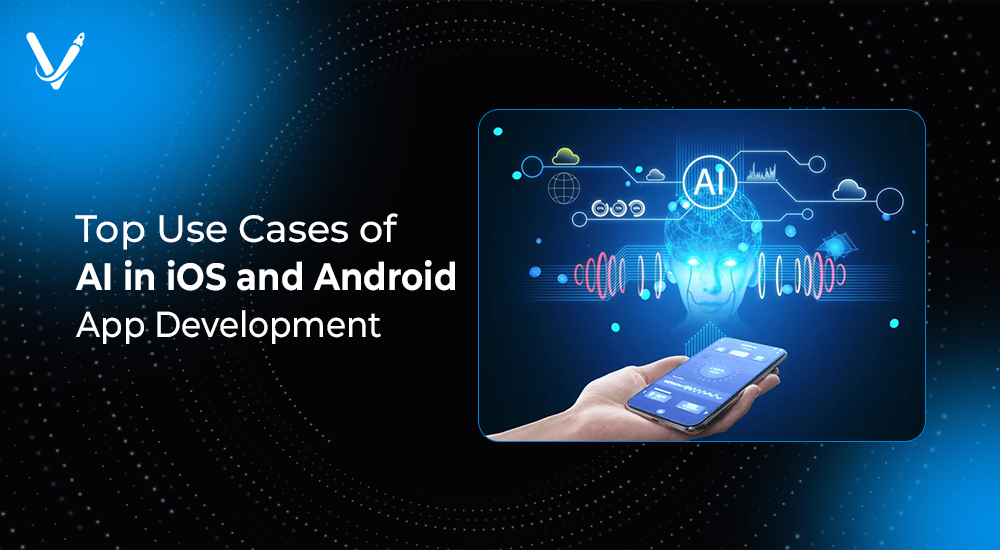Top Use Cases of AI in iOS and Android App Development


- Aug 4, 2025



Mobile apps have evolved beyond static interfaces and pre-programmed functionality. They’re now intuitive, predictive, and context-aware—thanks to the power of Artificial Intelligence. Across both iOS and Android platforms, AI is revolutionizing how apps interact with users, solve problems, and scale intelligently.
As users expect more personalized, intelligent, and real-time features, developers and businesses are increasingly embedding AI into their mobile experiences. Whether you're building a finance app, fitness tracker, social network, or eCommerce solution, AI can unlock transformative capabilities that boost engagement, retention, and growth.
This article explores the top use cases of AI in iOS and Android app development, real-world success stories, development tips, and the tools powering this next generation of mobile innovation.
Integrating AI into mobile apps enables experiences that feel personal, smart, and seamless. Instead of one-size-fits-all functionality, apps become context-sensitive and evolve based on user behavior.
Developers on both iOS (using Core ML, Create ML, SiriKit) and Android (via ML Kit, TensorFlow Lite, or custom APIs) can leverage powerful AI features without heavy infrastructure.
Let’s explore the leading AI-powered features shaping today’s mobile apps across industries and categories.
One of the most impactful applications of AI in mobile apps is content and experience personalization. Apps can dynamically adapt interfaces, offers, and content based on real-time behavior and preferences.
Example: Spotify’s “Discover Weekly” playlist, powered by AI models analyzing user preferences and global trends, reportedly increases time spent in the app by over 30%.
Actionable Tip: Use user segmentation + collaborative filtering to personalize feeds and product carousels within your app.
AI-driven chatbots and voice assistants streamline user interactions and provide 24/7 support, improving accessibility and reducing operational costs.
Example: Duolingo’s in-app AI-powered chatbot helps users practice language conversations in a natural, risk-free setting—leading to higher engagement and faster learning.
Actionable Tip: Start with text-based AI chatbots for FAQ or transactional queries, then expand to voice interaction using NLP APIs.
Predictive analytics helps apps anticipate user needs and deliver value before users even ask.
Example: Uber uses AI to predict where and when users are most likely to need a ride, optimizing availability and reducing wait times.
Actionable Tip: Collect and analyze user actions in-app, then train behavior models using tools like Firebase Analytics + TensorFlow.
AI-powered computer vision enables apps to identify objects, scan documents, detect emotions, and recognize faces.
Example: FaceApp uses AI for facial transformations, aging filters, and emotion changes, drawing millions of users worldwide through its viral functionality.
Actionable Tip: Add features like face-based login, photo filters, or real-time scanning with camera integrations for next-gen UX.
Speech-to-text and AI-based natural language understanding (NLU) transform voice input into commands or actions.
Example: Starbucks’ mobile app integrates voice ordering using NLP, allowing users to speak their order naturally and skip typing altogether.
Actionable Tip: Use speech interfaces for accessibility or speed in food delivery, banking, or ride-hailing apps.
Visual search combines AI and AR to let users identify products or objects by scanning them with the camera.
Example: IKEA Place allows users to visualize furniture in their space using AR and recommends similar items using visual search AI.
Actionable Tip: Let users upload images or use live camera input to trigger in-app searches or product matches—especially useful in retail, travel, and learning apps.
Security apps and fintech platforms increasingly rely on AI to detect fraud, flag unusual activity, and secure user data.
Example: Mobile banking apps like PayPal or Revolut use AI to flag suspicious transactions in real-time, reducing fraud losses by over 30%.
Actionable Tip: Incorporate rule-based and ML-based anomaly detection into any app handling payments, authentication, or sensitive data.
AI can enhance image quality, automate effects, and suggest edits in real time—perfect for photo, beauty, and social media apps.
Example: Instagram uses AI to recommend filters, detect facial landmarks for AR effects, and optimize images for engagement.
Actionable Tip: Use open-source AI models or ML Kit to integrate creative and intelligent image editing tools into your mobile app.
Live translation allows apps to instantly convert voice or text into another language, enabling global usage and breaking communication barriers.
Example: Google Translate’s instant camera translation and voice interpreter mode are widely used in travel apps to help users navigate foreign environments.
Actionable Tip: Add live chat translation or voice-based multilingual commands for international accessibility.
AI can analyze voice, facial cues, and text to detect user emotions, enabling context-aware experiences.
Example: Mental wellness apps like Wysa use AI to analyze user mood and recommend tailored content or exercises.
Actionable Tip: Use sentiment tools to improve feedback loops or customize notifications for different emotional states.
Here are the top tools you can use to integrate AI into your iOS and Android apps:
Sephora uses AR and AI to let users try makeup virtually. AI tracks facial points and adjusts lipstick or eyeliner in real-time.
Result: 200% increase in in-app engagement, 30% boost in product conversions.
Hopper uses AI to predict flight prices and suggest optimal booking times.
Result: Saved users millions by recommending smarter purchase decisions, earning over $1 billion in bookings annually.
Replika offers an AI companion that learns and adapts to the user’s behavior, using deep learning and NLP to provide emotional support.
Result: Over 10 million users and average daily session time of 25+ minutes.
While AI offers game-changing features, it comes with challenges:
Solution: Use a hybrid approach—on-device AI for speed, cloud AI for heavy processing. Always prioritize transparency and consent.
AI is no longer a niche feature—it’s a necessity for creating mobile apps that resonate with modern users. Whether you’re enhancing UX with personalized recommendations, streamlining support with chatbots, or introducing intelligent camera features, AI gives your app a competitive edge.
Both iOS and Android platforms offer powerful tools to help developers get started. And with frameworks like Core ML, TensorFlow Lite, and ML Kit, integrating AI into your mobile product has never been more accessible.
At Vasundhara Infotech, we specialize in building AI-powered iOS and Android apps that delight users, scale efficiently, and deliver tangible business value. Whether you're starting a new project or upgrading an existing one, our team is ready to turn your vision into reality—with intelligence at its core.
Ready to integrate AI into your mobile app? Partner with us today and lead the next wave of smart app innovation.
Copyright © 2025 Vasundhara Infotech. All Rights Reserved.